BONGO FURY: WORKING WITH DON VAN VLIET
In 1975 Zappa started working with Don Van Vliet again, his friend from high school days onwards.
Don had also been successful in starting a career in music, releasing several albums as "Captain Beefheart". Zappa cooperated with Don on record
on two occasions. In 1969 Don sang the lyrics of "Willie the pimp" on Zappa's "Hot Rats" and Zappa produced Beefheart's
"Trout mask replica" for his Discreet Records label. Then Don started accusing Zappa of all sort of things in the press and their friendship
appeared to have halted. But in 1975 he was without a record contract and returned to Zappa for help, tuning down his hostile tone
of the past years. They decided to do a short tour with the Mothers including Beefheart and a deal was made that Beefheart could
do a new album for Discreet. It wasn't something that could last because Beefheart was only of limited use for The Mothers,
singing the pieces suited for him, and most of the time he sat at the side of the stage making drawings (photo to the right).
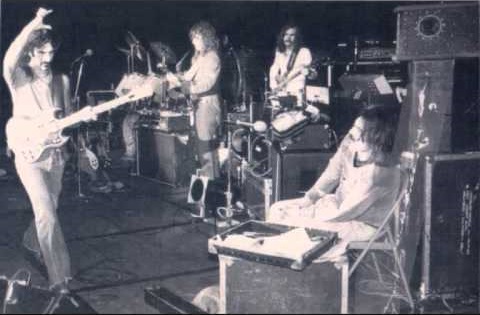 From the tour the "Bongo fury" album was done, also including some studio material. Because the tour was short Zappa
couldn't have everything developed as thoroughly on the road as he usually did, if he wanted the album to be coherent.
For the live albums from the seventies Zappa recorded the tracks mostly at one location, so that the listener could get the idea of
being at a specific concert. From "Sheik Yerbouti" (1979) onwards he changed this approach to combining the best tracks
from different locations. The "Bongo Fury" live songs stem from the two concerts at the Armadillo world headquarters, Austin, Texas, May 1975. Here he allowed or was
forced to allow imperfections as one time too much "heh-heh-heh" on "Advance romance", less sparkling solos and seconds with voids
in "Carolina hard core ecstasy". So when he had to laugh during the reciting of the lyrics from "Muffin man", he may have decided he might leave that in just as well.
It doesn't do much harm though.
From the tour the "Bongo fury" album was done, also including some studio material. Because the tour was short Zappa
couldn't have everything developed as thoroughly on the road as he usually did, if he wanted the album to be coherent.
For the live albums from the seventies Zappa recorded the tracks mostly at one location, so that the listener could get the idea of
being at a specific concert. From "Sheik Yerbouti" (1979) onwards he changed this approach to combining the best tracks
from different locations. The "Bongo Fury" live songs stem from the two concerts at the Armadillo world headquarters, Austin, Texas, May 1975. Here he allowed or was
forced to allow imperfections as one time too much "heh-heh-heh" on "Advance romance", less sparkling solos and seconds with voids
in "Carolina hard core ecstasy". So when he had to laugh during the reciting of the lyrics from "Muffin man", he may have decided he might leave that in just as well.
It doesn't do much harm though.
1. Debra kadabra
"Debra kadabra" featuring Beefheart is a song where the melody is made up of several sections with motifs, that can get repeated and varied upon,
going from one motif to another, often changing the tempo. The quick movement through various motifs is a way of structuring
that Zappa would repeatedly return to. It became dominant in "St. Alphonso's pancake breakfast/Father O'Blivion" from "Apostrophe (')" and "Zombie woof" from "Overnite sensation". On "Bongo fury", "Cucamonga" is another example and I'll return to this topic in the "Drowning witch" section. Here's a transcription of a section of the opening of Debra Kadabra.
Debra Kadabra, opening (midi file).
Debra Kadabra, opening (transcription).
It's built as:
a) Tempo I, moderate tempo.
- Bars 1-3 in 4/4. Opening guitar riff motif, repeated from the beginning of the song through 0:23, with Captain Beefheart reciting the text.
b) Tempo going from tempo I to tempo II, faster.
- Bar 4-5. Transitory bars. The guitar ends in tempo I. The drummer starts with 5/8 in tempo II.
c) Tempo II.
- Bar 6 in 12/8. A twice repeated motif starts. Beefheart has begun singing.
d) Tempo going from tempo II to tempo III, a little faster.
- Bar 7-8. Transitory bars. Beefheart ends with "(con)-fetti" in Tempo II. The bass guitar starts with 5/8 in tempo III.
e) Tempo III.
- Bar 9, 14/8. Instrumental motif, played once.
- Bar 10, 11/8. Eleven drumbeats.
- Bar 11-13, 12/16. Three times repeated motif.
The first three motifs in bars 1-10 have in common that they are built upon A. The first one has frequent off-beat drumming, but mostly a downbeat on
the bass drum. The guitar plays through the Am7 chord. The scale is A Dorian, with the F# from this scale to appear first in bar 6.
This second motif in bar 6 is a 12/8 on beat movement with a IV-I progression in A Dorian. The third one
in bar 9 begins with some fourth intervals and also ends on A. The chromatic fourth motif in bars 11-13
sets a new direction. This procedure continues till the end of the song. It needs time for rehearsing
and memorizing to play pieces like this.
Debra Kadabra, 2:35-2:56 (midi file).
Debra Kadabra, 2:35-2:56 (transcription).
The lyrics of "Debra Kadabra" are about common youth memories of Beefheart and Zappa. The larger part at first only understandable
among themselves, though Zappa would explain some of its episodes in later interviews, for instance what the film The Brainiac was about
(a Mexican horror film from 1962, the Spanish title being El baron del terror).
Some lines from the lyric renditions on the net are attempts to mold the text into a more understandable form.
When you listen to the lyrics phonetically, I have my doubts.
I don't have a clue what several phrases should be either. Frankly I don't think Zappa wanted
these lyrics to be understandable and Beefheart's shouting them works here quite effectively in creating an atmosphere of
controlled madness. It is for this reason and the contrariness with the abstract complexity of most of the song that the minor third
movement of the ending theme comes out so strong. The emotions suddenly become very recognizable, at least musically. The second example
has this transition to a degree. It's also in odd meters (5/8, 9/16 and 7/16) and also including a tempo change. Bars 1-2
represent the bass motif in D Dorian as it is played during the section with Beefheart reciting the lyrics. You can't get Beefhearts voice
here properly into standard midi format.
In bar 8 the song changes to what can be interpreted as E Dorian with the chord progression I-IV-V-IV
(the minor third movement then seen as the I chord). Over it the IV chord keeps being sustained in the descant (keyboard chord from staff 1). It's also
possible to explain it as A Mixolydian with the whole of bar 8 seen as A7, but when Beefheart
starts singing the A chord has (temporarily) stopped and the single minor third towards E dominates.
The lyrics, "Cast your dancing spell my way, I promise to go under it", are a qoute of a line from
"Mr. Tambourine man" by Bob Dylan.

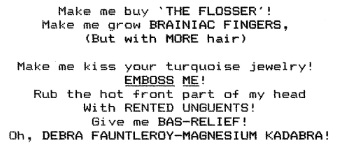
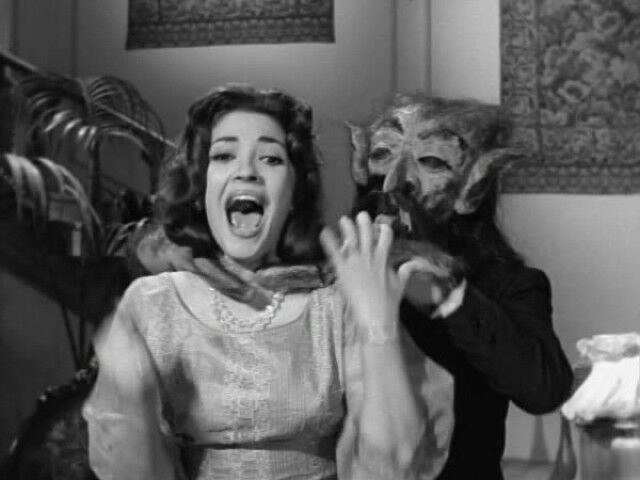
On pages 152-3 of the 1984 "Them or us" book part of the lyrics from "Debra kadabra" are being reproduced (Pinter & Martin edition).
Regrettably not all of them. To the right a screenshot from The Brainiac (1962) with his fingers attacking one of his victims. He also had a rubber tongue to suck the brains out off his victims.
This movie has obtained some cult status.
2. Carolina hard-core ecstasy
"Carolina hard-core ecstasy" is available in three live versions. Two in Zappa's own catalogue, one by the ZFT. Below I'm comparing
the instrumental opening bars of these renditions, that cause different analyses of especially the harmony. The meter is all 4/4, but
there are smaller rhythmic differences too.
Carolina hard-core ecstasy, Bongo fury, opening bars (midi file).
Carolina hard-core ecstasy, Bongo fury, opening bars (transcription).
- bars 1-4. Theme one of two bars, played twice. The chord progression is C-Em-Am7-D.
- bars 5-8. Theme two of two bars, also played twice. This is a small melodic line, where the second bar is a rhythmical
variant upon the first one.
The key is unmistakably C Lydian. With also the sung theme three following upon it, this
seems to be the only interpretation, that's logically possible. Nevertheless, the 1984 execution necessitates a re-assessment
of this situation. Not by changing notes, but by adding diatonic notes, that weren't used in some bars of the 1975 performance.
Carolina hard-core ecstasy, YCDTOSA Vol. IV, opening bars (midi file).
Carolina hard-core ecstasy, YCDTOSA Vol. IV, opening bars (transcription).
- bars 1-2. Here you have an A bass pedal, while the bass paused in 1975. So these two bars are in A Dorian in the 1984 version.
- bars 3-4. In bar 4, staff 5, you've got an additional figure with an F natural.
- bars 5-8. With this figure continuing, the F only shows up as natural during these bars, while in the 1975 version the F/F# isn't used. So
the 1984 version sets these bars to C major. There are some minor rhythmic differences between the 1975 and 1984 versions and the
high descant keyboard part is handled differently. In the 1975 version this keyboard plays along with the lead melody, to a point,
while in 1984 it's just a sustained fourth (A-D).
- bars 9-10. The sung bars start, now stable in C Lydian.
One always has to bear in mind that analyses of Zappa's songs in this study are based upon the specific execution, being mentioned.
Much of it will also apply to other versions, but it can't be taken for granted. It may also be that future releases by the ZFT or
original scores shine yet another light upon several compositions. In this case one might conclude that the "Carolina hard-core ecstasy"
intro is brightly in Lydian (1975 version), while the 1984 performance does the opposite. Instead it's an example of mingling major and Lydian,
like Zappa also did in "Echidna's arf (of you)" and "Inca roads".
Carolina hard-core ecstasy, FZ:OZ, opening bars (midi file).
Carolina hard-core ecstasy, FZ:OZ, opening bars (transcription).
The opening of the "FZ:OZ" version from 1976 does sound somewhat different. Here the chord progression from theme one has been changed
to C-Em/Cmaj7-Bm-D, so with a Bm chord instead of an Am7 chord.
The guitar solo in this song is upon a pedal note, a G-F figure. With the F being the lower note and being sustained far longer, I consider the F
the tonic for the solo and the key F Lydian at this point. In his response to me you can read that Brett Clement prefers the G to be seen as
tonic. In that case the key for the solo would be G Mixolydian.
3. Sam with the showing scalp flat top
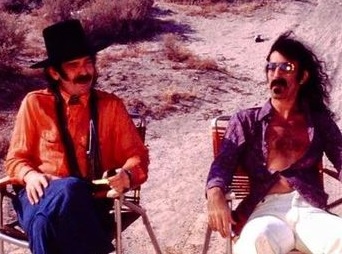 Track 3 is one of the two poems Don is reciting. It does have some shorter accompanying motifs by the band. Beefheart gets credited solely,
so it can be assumed that these motives are written by him. The title of the album is derived from the final phrase, "I wish I had a pair of bongos, bongo fury".
Track 3 is one of the two poems Don is reciting. It does have some shorter accompanying motifs by the band. Beefheart gets credited solely,
so it can be assumed that these motives are written by him. The title of the album is derived from the final phrase, "I wish I had a pair of bongos, bongo fury".
To the right: Zappa and Beefheart in the desert. It's an
outtake from a photo from the Bong fury cover session, the photographer thus being John Williams. Eventually they decided to use a shot with them sitting
in a cafeteria.
4. Poofter's froth Wyoming plans ahead
"Poofter's froth Wyoming plans ahead" is mainstream country music, a cowboy song about the in 1975 upcoming 200 years birthday of the U.S.A., as Zappa is saying during its introduction. Quite in its place
in Austin, Texas. Beefheart is singing it with his usual odd voice, but on this occasion one might like to hear it with normal singers too.
The lyrics are about a fictional location of a producer of bicentennial merchandise, Poofter's froth in Wyoming, serving as an example of a producer of
"things you shouldn't ought to buy", according to the song's introduction.
Poofter's froth Wyoming plans ahead, 2:40-3:03 (midi file).
Poofter's froth Wyoming plans ahead, 2:40-3:03 (transcription).
The harmonies of the song form a series of parallel major triads. It starts instrumentally with playing around G. Next the first theme follows with
C-D-G. The second theme is using F-C-D-G. This parallel playing is also coming by in the Studio tan section of this study at the modulations paragraph.
It makes it difficult to assign such music to one particular key, only nominally it might be called C Lydian. The example above is the end of this
song, where some chromaticism is taking place. Bars 1-3 are the first theme for the last time, followed by a short coda, bars 5-6.
The final bar in 5/4 isn't a genuine meter change. It comes from ending in a rubato manner and cutting off the tape.
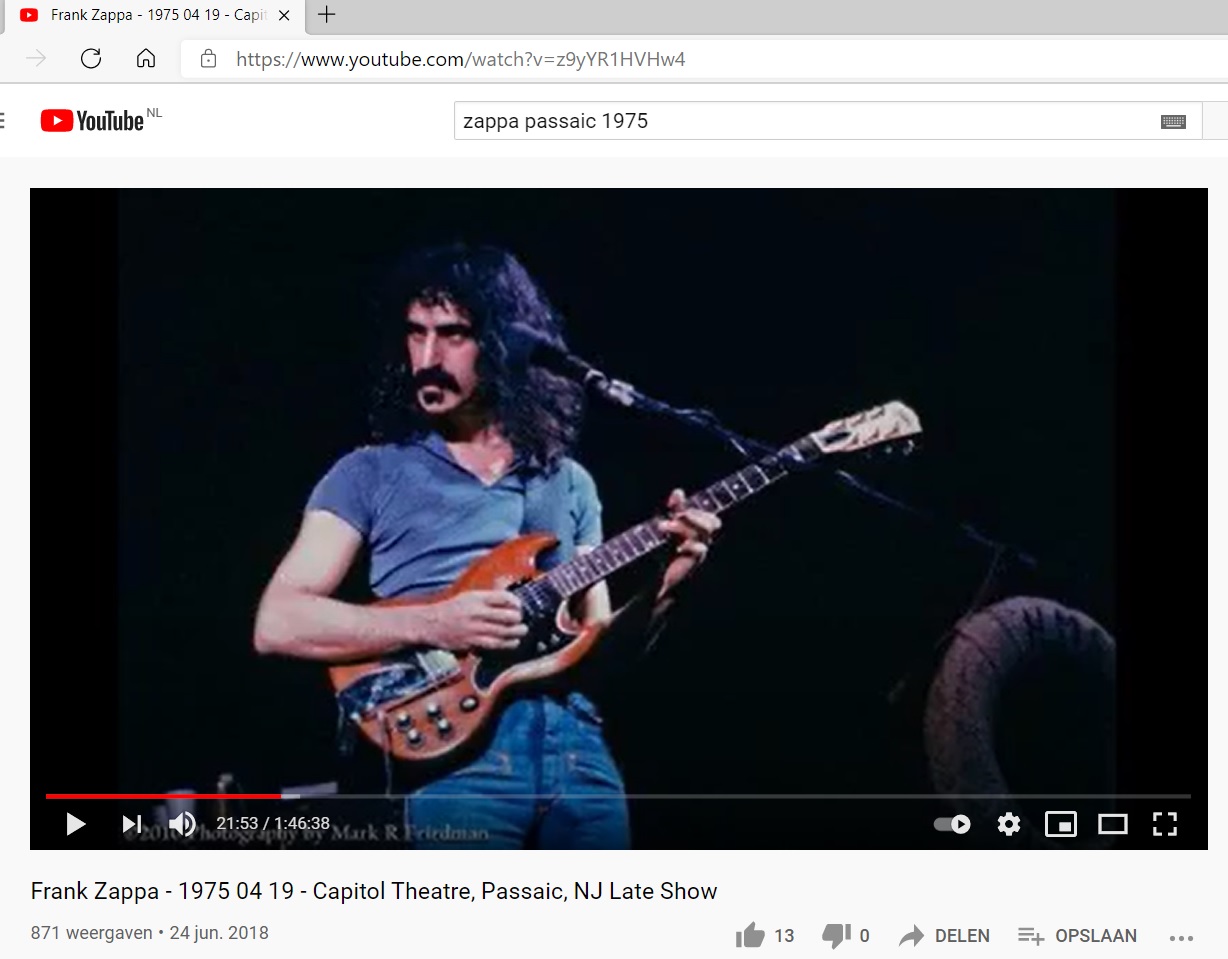
Sometimes bootlegs can come in handy for further explications. In the Ulrich book Zappa's introduction of this song during
a 1975 concert at Passaic, New Jersey, gets quoted, that is also available on Youtube:
"This is a country and western song, and uh, I have to explain to you what it's all about, you see, just the words
are slightly obscure, even though it's a cowboy song. The name of this song is Poofter's froth Wyoming plans ahead.
The subject matter of this song is, as you know, next year is the 200 years anniversary of our wonderful country that we live in here.
We're sure that you realize that as soon as 1976 rolls around everything that you see and hear about
the 200th anniversary is going to be so crap, so commercial, and so cheesy that you won't
believe it. Well, I'll tell you something for that matter, all over ..., all over the United States people that are manufacturing
doodad, are preparing the special bicentennial doodad crop, which is going to be unleashed as all sorts of trinkets
and sleazy things to take your money away from you in 1976. And this song is only to indicate that the planning for this
sleaze attack has been going on for quite some time. It orginated in a small isolated
community in Wyoming called Poofter's froth, which was originally settled by a group of English morphodites."
5. 200 years old
With tracks 4-5 Zappa is on far more familiar grounds than during the album opener. "200 years old" is blues. He liked the blues as a teenager and
he would repeatedly return to it during his career. On "The lost episodes" we can hear him playing through the blues scheme with his brother Bobby
in "Lost in a whirlpool", when he had just learned to play guitar in 1958. Some other later blues recordings are "Big leg Emma" on "Zappa in New York"
and "In France" on "Them or us".
"200 years old" starts with a riff build around a traditional blues motif, here played in G Dorian
as G-C-B flat-G by the piano (in the 4th pdf version of this study I'm calling this example minor, but I misheard a chord: the E is natural). Some extra
is given to it by a counter-movement F-C-F sharp-G by the synthesizer.
200 years old, opening bars (midi file).
200 years old, opening bars (transcription).
During the song the traditional blues chord pattern is followed (I-IV-I-V-IV-I). Here in G Dorian with starting points:
- I. 0:29. The melody as above continues. Zappa tells about his thoughts at an early breakfast.
- Basically I. 0:57. Beefheart sings the theme of the song.
- IV. 1:26. Harmonica solo starts.
- I. 1:32.
- V. 1:39.
- IV. 1:42.
- I. 1:46.
- I. 1:52. Guitar solo begins. The blues scheme recommences.
Or in "Big leg Emma" from "Zappa in New York" in E (major/Mixolydian):
- I. 0:07.
- IV. 0:14.
- I. 0:18.
- V. 0:22.
- IV. 0:24.
- I. 0:25. Etc.
For complete blues scheme transcriptions, see:
- the Movie scores section with "The world's greatest sinner".
- The Cucamonga years section with "Grunion run".
- The Zappa in New York section with two examples from "Big leg Emma".
- The Läther section with "Duck duck goose".
- the Sheik Yerbouti section with "Dong work for Yuda" (Hammersmith Odeon version).
- the You are what you is section with "Suicide chump".
- the Guitar section with "Sexual harassment in the garage".
See the Imaginary diseases section at "Been to Kansas City in A minor" for more about blues.
6. Cucamonga
The transcribed section of "Cucamonga" below is characterized by the permanent changing between 2/4 and 3/4 and
changing between two scales. It has an instrumental introduction of some normal 4/4 bars in A Mixolydian. Then the sung theme
starts in Eb Dorian in 3/4. In bar 8 the meter changes to 2/4 and in bar 9 the key has become G Lydian. The modulation
is done chromatically in bar 8. First Eb becomes E, then Ab becomes A, next Gb and Bb turn into G and B. This idea
keeps returning in the song.
Cucamonga (1975), section (midi file).
Farther O'Blivion (1972), Cucamonga, opening (midi file).
Cucamonga (1975), section (transcription).
Farther O'Blivion (1972), Cucamonga, opening (transcription).
At first "Cucamonga" didn't exist as a separate song. It was played in 1972 and 1973 as the finale of a larger composition,
called "Farther O'blivion". It can be found this way on "Imaginary diseases" by the ZFT and the "Piquantique" bootleg.
The "Big swifty and associates" part of "Greggery peccary" was the opening of this piece while the "Be-bop tango" formed
the middle block. See the Roxy section for the tango part. The opening of "Cucamonga" in this manner is also presented
above, transcribed from "Imaginary diseases" (1972). Here it's arranged for a brass band and has no words. For the "Bongo fury"
version Zappa followed the original quite literally. Normally Zappa's rhythms are speech influenced, here it's the other
way round. The lyrics were added later on. Sometimes the rhythm of the words fits in normally, as for "many years
ago". At other instances this is not the case, as for "cu-ca-mon-ga". In spoken language these syllables are of about equal
duration. In the sung section of bars 5-7 the "cu" and "mon" syllables last much longer than the "ca" and "ga" syllables. Thus you get a peculiar
type of diction. It sounds interesting for a change, with the "Farther O'blivion" version explaining how it came into being.
Zappa apparently liked it this way. Otherwise he would have adapted the rhythm of the melody to the words.
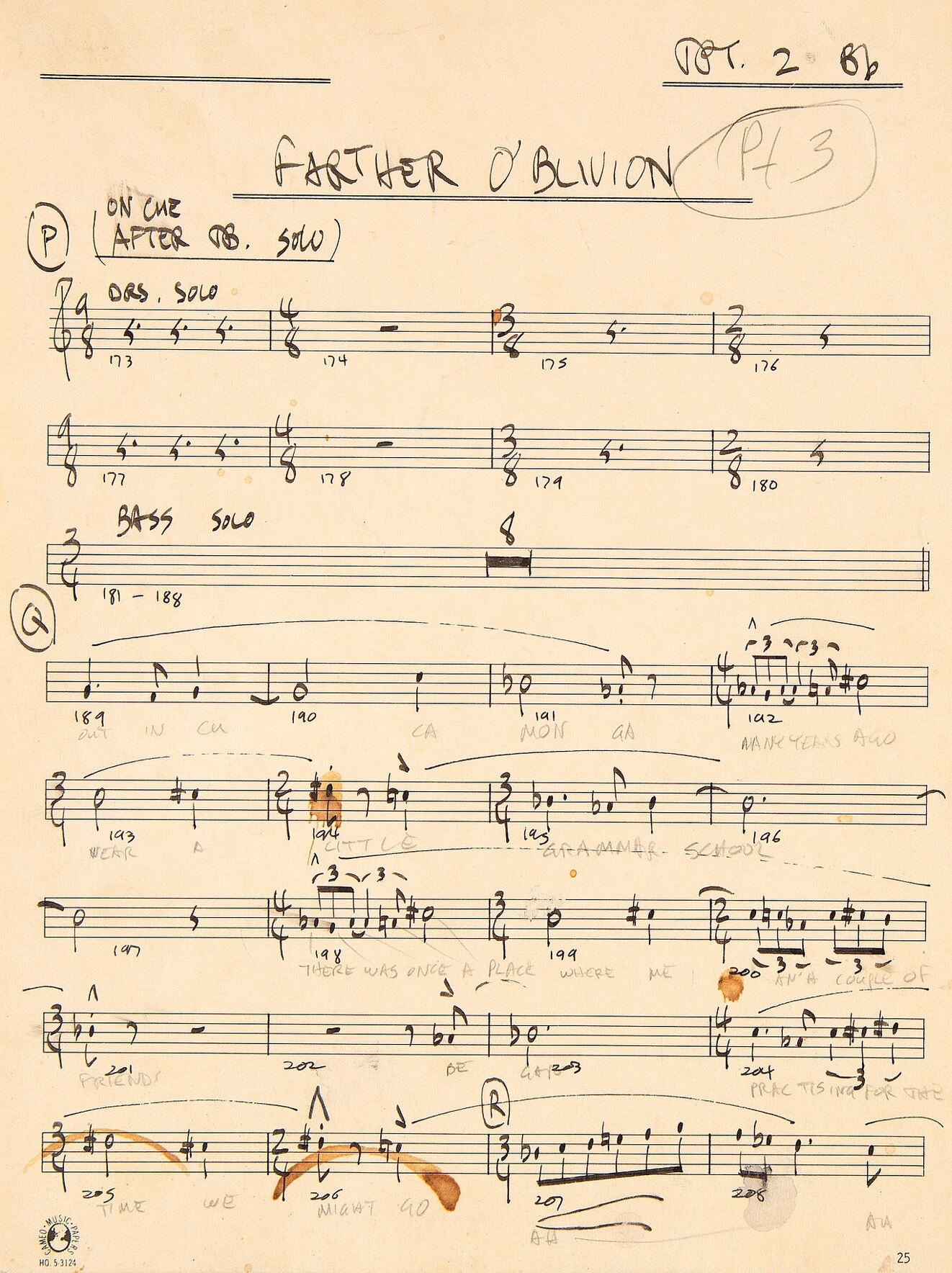
In april 2021 I came across bars 173-208 from "Farther O'blivion", auctioned at Heritage Auctions. Sections Q and R on this page are the first half of the "Cucamonga" block.
This sample page contains the trumpet #2 part for a trumpet in Bb. Not all of its notes are present in my transcription, so the harmonies might be wider,
at least on paper. The added lyrics in pencil are in Zappa's handwriting too, showing that they got inserted later on.
7 Advance romance (1975)
The lead melody from "Advance romance" can be found in the Ludwig study, page 268. Next is the main theme, as transcribed by him.
It's notated as if in G minor, but in the context of the whole song, G Dorian suits better (the solos are in Dorian). The E/Eb however,
that makes the difference, is
avoided during the main theme:
Advance romance, main theme (transcription).
- 0:00 Little instrumental intro with phrase one from the main theme.
- 0:08 Main theme. As you can see, the main theme is made up of three phrases. The meter is 4/4,
occasionally interrupted by a bar in 3/4 or 2/4. Triplets and altered notes are getting used. Notable
is the wide vocal range, used for the lyrics. It's sung by Napoleon Murphy Brock.
- 2:39 Solo in G Dorian by Denny Walley on slide guitar.
- 3:55 Harmonica solo by Don van Vliet.
- 4:56 Second guitar solo by Zappa himself.
- 8:49 Main theme variations.
See the YCDTOSA Vol. V, disc 2 section for further details from the "Advance romance (1982)" version.
- 11:04 Coda.
- 11:17 End.
Advance romance (Ljubljana), 4:44-5:26 (midi file).
Advance romance (Ljubljana), 4:44-5:26 (transcription).
In 2022 the ZFT released "Zappa '75 Zagreb/Ljubljana" with another "Advance romance" live performance, recorded a couple of months later.
The example from above is an outtake of Zappa's guitar solo. The accompanying vamp is the same as the one on "Bongo fury", a two-bars figure in G Dorian.
From bar 8, beat 4, onwards you can see Zappa switching to G Mixolydian, while Andre Lewis (synthesizer) stays in G Dorian. Dorian and Mixolydian
differ by only one note (Bb versus B natural in this case) and mingling them is common in Zappa's music. This example could also be called hexatonic:
the A gets largely avoided. Only Roy Estrada touches upon an A in bars 2 and 6.
8. Man with the woman head - The torture never stops (original version)
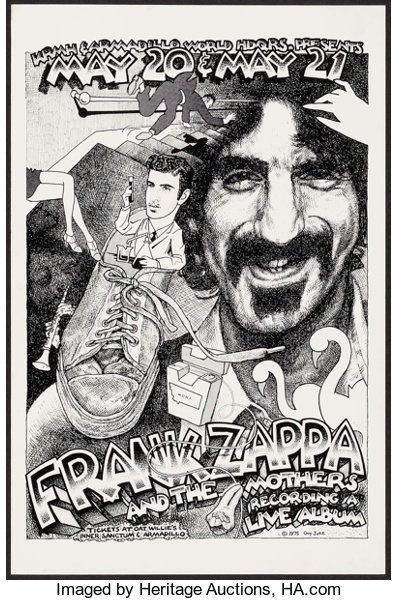 "Man with the woman head" is the second poem Don is reciting. At this point Don could recite the text from Zappa's "The torture never stops"
too as if it was a poem. These lyrics preceded the later song on "Zoot allures". On "YCDTOSA Vol. IV" you can hear this particular performance, accompanied
by a vamp. Also this track was recorded at the Armadillo world headquarters.
"Man with the woman head" is the second poem Don is reciting. At this point Don could recite the text from Zappa's "The torture never stops"
too as if it was a poem. These lyrics preceded the later song on "Zoot allures". On "YCDTOSA Vol. IV" you can hear this particular performance, accompanied
by a vamp. Also this track was recorded at the Armadillo world headquarters.
The torture never stops (original version), section (midi file).
The torture never stops (original version), section (transcription).
The example above is to be heard between 1:28 and 1:48. Bars 1-2 and 13-14 contain the vamp with Beefheart speechwise singing. Bars 4-12 contain an instrumental interlude, that sometimes gets inserted
in order not to make this song too static. It's in C Dorian, though the A/Ab that makes the difference with C minor is absent in the example. From 6:10 to the end Beefheart (harmonica)
and Denny Walley (guitar) are soloing. An A natural can be heard at for instance 7:09.
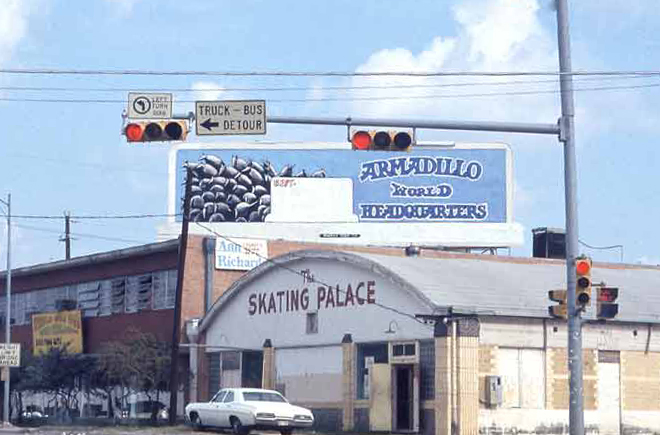
The Armadillo world headquarters along Wikipedia, Austin, Texas. This hall had a reputation for being alternative, as earlier the Fillmore had. In 1980 it had to close because
of financial problems. The poster, above to the right, auctioned at Heritage Auctions, shows that Zappa planned to record a live album at this venue in advance.
Apparently he liked to dine there too, because he's thanking the kitchen on the album's back sleeve.
9. Muffin man
"Bongo fury" ends with the hilarious concert closer "Muffin man", a song that everybody seems to like. It has a four-bar central
theme in F# Dorian. After being sung, it's used as a vamp for a guitar solo. The album has a studio recorded introduction with George
Duke on keyboard and Zappa reciting a text about the laboratory of the muffin idolater. The second midi file includes the last bars,
but it's hard to catch the words of someone speechwise singing/talking into midi format. It has no alphabet and sounds
as a cheap imitation. You can open it for what it's worth.
Muffin man, theme and solo opening (midi file).
Muffin man, recitative, end (midi file).
Muffin man, section (transcription).
The bars with the recitative can hardly by assigned to scales. Bars 1-2 contain the chord progression Daugm.-Faugm.-G#dim. Next you get a two-bar figure
that gets varied upon. Central stands a descending third as in bar 4. It returns four times, each time a minor third higher. From bar 8 through bar 13
the piano part in the F clef staff follows a sort of a walking bass line to accompany it. In the Ludwig study (page 223) the central theme in bars 14-16 gets
explained as a I-IV-V progression (with F#-B-C# as the central notes), an example of Zappa following an easy chord progression. Indeed you can harmonize
the theme in this manner and the theme does sound familiar.
In 1976 Zappa's partnership with Herb Cohen came to an end. Cohen had been successfully managing The Mothers, especially in the first years,
and had set up Discreet Records with Zappa as a label of Warner Brothers. Discreet was used as a vehicle for Zappa's albums but the main reason
for its existence was business, namely earning money be contracting groups for it. In 1976 Zappa found that Cohen was allocation
the incoming money with too much liberty. The financing of the recording of Beefheart's new album "Bat chain puller" for the label was
the direct cause for the breach. Zappa thought that it had been paid for with money that was his. So Zappa as president of Discreet
set Cohen aside and Cohen counterattacked with a lawsuit, demanding that Zappa's assets were to be frozen during the trial and that he would have
no access to the tape archive, which was granted. At the same time Zappa had started dealing with MGM, who had brought out the first
five records. They were bringing out compilations without paying him appropriate royalties. This case was solved relatively quickly. Zappa obtained
the mastertapes and a financial compensation. But since the tapes went into the Discreet inventory it was to no direct avail.
Zappa's next "Zoot allures" album and Beefheart's new album were to be released on Discreet. He had safety copies
of the tapes in his house and could release his album on
the Warner Bros. main label, on condition that he indemnified them in case Cohen could lay any claim upon it. But Beefheart
was forced to record several tracks anew for his later "Shiny beast" album with "Bat chain puller" added to the title between brackets.
The original recordings are still in Zappa's vault today, officially released in 2012. Beefheart made two more albums in the early eighties and then had
enough of the music business. Since then he continued with his second career as an art painter.
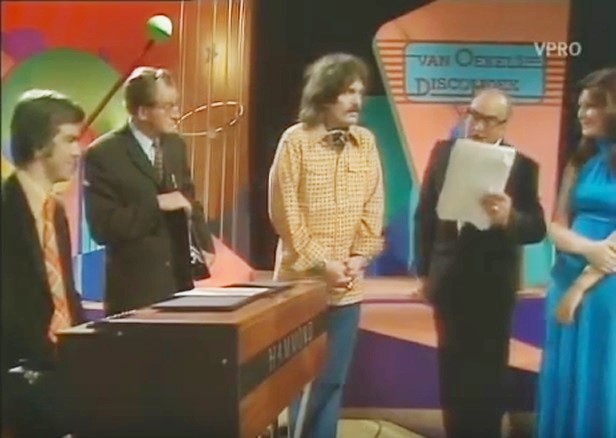
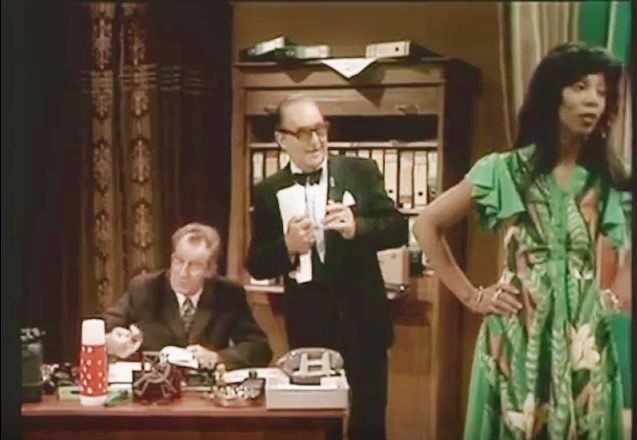 To the left Don's appearance at the Van Oekel disco show (VPRO television), singing "Upon the my-oh-my". This Dutch show was (in-)famous for its subdued
mockery of decency standards. The best known episodes are Van Oekel having to throw up live during a Christmas show and Donna Summer singing "The hostage"
before she really got famous. You've got their accountant Van der Pik (John van Dick) mistakenly picking up the ransomer's phone call as if it's just
another call, and Donna reacting accordingly (of course understanding the fun of it). You can find these episodes on Youtube. It's hilarious, also without
understanding Dutch.
To the left Don's appearance at the Van Oekel disco show (VPRO television), singing "Upon the my-oh-my". This Dutch show was (in-)famous for its subdued
mockery of decency standards. The best known episodes are Van Oekel having to throw up live during a Christmas show and Donna Summer singing "The hostage"
before she really got famous. You've got their accountant Van der Pik (John van Dick) mistakenly picking up the ransomer's phone call as if it's just
another call, and Donna reacting accordingly (of course understanding the fun of it). You can find these episodes on Youtube. It's hilarious, also without
understanding Dutch.
